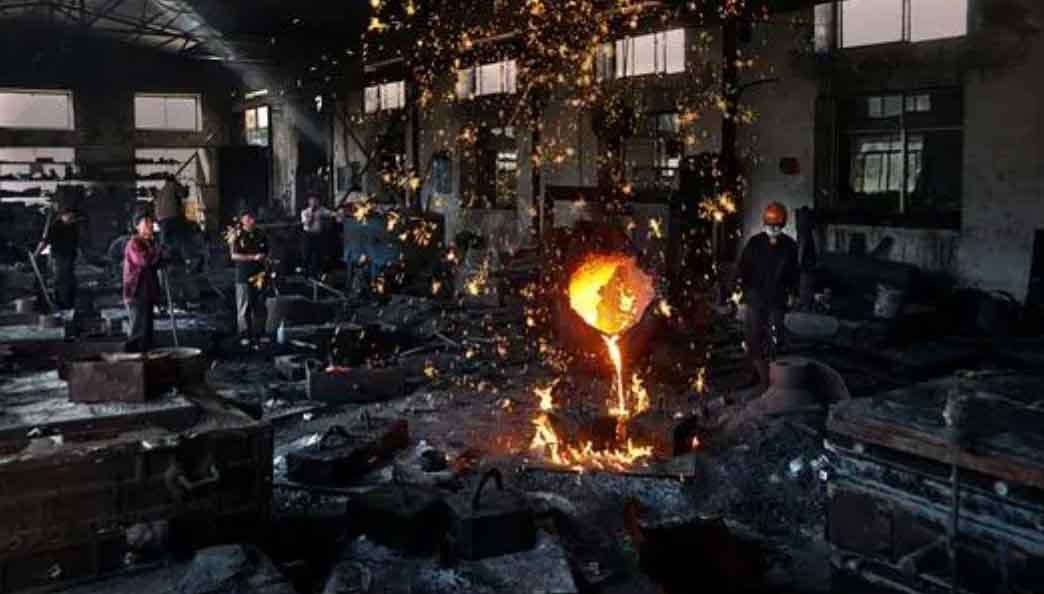China’s steel casting industry has undergone transformative technological advancements, significantly enhancing the quality of large and medium steel castings. This evolution is driven by sophisticated equipment, computational tools, and refined process controls. Below, we explore key developments, service domains, and quality optimization methodologies.
1. Technological Evolution in China Steel Casting
Equipment modernization remains central to quality enhancement. Open-hearth furnaces were phased out by 2005, replaced by high-power electric arc furnaces (EAFs), ladle refining furnaces (LRFs), and VD/VOD units. This enables dual/triple smelting configurations:
- $$ \text{EAF + LRF} \quad \text{(Dual)} $$
- $$ \text{EAF + LRF + VD} \quad \text{(Triple)} $$
Advanced analytical instruments—optical emission spectrometers, carbon-sulfur analyzers, and gas detectors—ensure precise compositional control. Heat treatment furnaces achieve thermal uniformity of ±5°C and efficiency >30%, with fully automated process execution.

Computer-aided engineering (CAE) solidification simulation, exemplified by domestically developed tools like Huazhu CAE, optimizes feeding systems and defect prediction. Adoption of computer-aided process planning (CAPP) systems enables paperless workflows and centralized data management.
Sand reclamation breakthroughs resolve chronic challenges with water glass sand. Spiral vibration and friction-based regenerators achieve 20-ton/hour capacity with high de-coating rates. Key metrics:
| Method | De-coating Rate | Operating Cost | Environmental Impact |
|---|---|---|---|
| Wet Regeneration | High | High | Alkaline wastewater |
| Pneumatic Regeneration | Medium | Medium | High sand loss |
| Friction-Based Regeneration | High | Low | Minimal |
2. Primary Service Domains for China Steel Casting
Large and medium steel castings serve critical sectors:
| Industry | Key Components |
|---|---|
| Metallurgy | Rolling mill frames |
| Building Materials | Grinding mills, crushers |
| Power Generation | Turbine casings |
| Shipbuilding | Rudders, propeller shafts |
Record castings exceed 470 tons, reflecting China steel casting’s scalability.
3. Quality Optimization Framework
Over 80% of defects originate during pouring/solidification. Key strategies include:
3.1 Pouring Velocity Enhancement
Quartz sand expansion causes gas holes/sand inclusions. Phase transition from α-quartz to β-tridymite at 870°C induces 17.26% volumetric growth:
$$ \Delta V = V_0 \times 0.1726 $$
To mitigate radiation-induced expansion, pouring time must be minimized:
- Ideal: ≤30 seconds
- Maximum: ≤60 seconds
Solutions include:
- Increasing ladle nozzle diameter
- Multi-nozzle configurations
- Synchronized multi-ladle pouring
3.2 Gating System Design
Open systems with tangential in-gates prevent turbulence. Step-gating is essential for tall castings, with in-gates positioned below risers to avoid thermal hotspots.
3.3 Pouring Temperature Control
Lower temperatures reduce slag formation, shrinkage, and hot tearing. Recommended superheats:
$$ \text{With argon stirring: } T_{\text{pour}} = T_{\text{melting}} + (30 \text{ to } 50)^{\circ}\text{C} $$
$$ \text{Without argon stirring: } T_{\text{pour}} = T_{\text{melting}} + (40 \text{ to } 60)^{\circ}\text{C} $$
Ladle bottom argon injection improves fluidity and inclusion floatation.
3.4 Riser Management
Covering agents must sustain insulation >30 minutes. Heat loss distribution:
| Component | Heat Loss (%) |
|---|---|
| Riser Top | 60–70 |
| Riser Walls | 30–40 |
3.5 Water Glass Quality Control
Modulus (M), density (ρ), and impurity content (NaCl, Na₂SO₄) critically impact binder strength. Aging reduces strength by 30–35% in 90 days:
$$ \sigma_t = \sigma_0 \times e^{-kt} $$
where \( \sigma_t \) = strength at time \( t \), \( \sigma_0 \) = initial strength, and \( k \) = aging coefficient. Optimal usage within 15 days is critical.
3.6 Steel Purity Enhancement
Reducing S/P directly lowers inclusions. For a 10-ton casting:
$$ \text{Inclusion Reduction} = 10 \times \left( [S]_i – [S]_f \right) \times 1.72 + 10 \times \left( [P]_i – [P]_f \right) \times 2.28 $$
where \([S]_i, [P]_i\) = initial concentrations (%), \([S]_f, [P]_f\) = final concentrations (%). Basic furnace practices combined with argon stirring achieve efficient desulfurization.
3.7 Riser Cutting Protocol
High-temperature cutting (>500°C) minimizes cracking risk. Delayed heat treatment after cutting must not exceed 4 hours.
These integrated strategies position China steel casting at the forefront of global heavy-industry supply chains, balancing precision and scalability.
